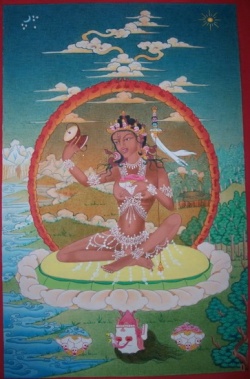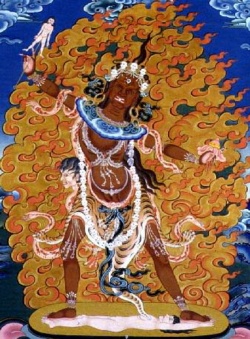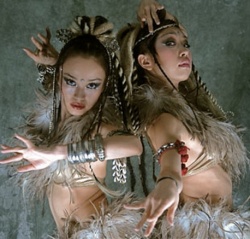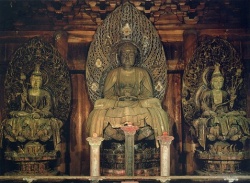The Successive Steps of the Teachings in the Path
This will be expounded in two categories: first, the basic teachings in the path; second, the teaching of improvement.
In the first category lie
(1) the principle of the Path and
(2) the ramification teachings of the path-Transformation Yoga and the Entrance Yoga. In the former there also lie two divisions:
(1) The exposition of the gathering of prana in the Central Channel and the manner of the arising of the four blisses.
(2) Relying on the foregoing experience, instruction on practicing the Illusory Yoga and Light Yoga.
Of the first there are also two divisions:
(1) The inner practice of Heat Yoga.
(2) The outer practice of Karmayoga.
The first again has two divisions;
(1) Through the practice of Dumo the prana is led to the Central Channel.
(2) By means of the entrance of the prana the manner of the arising of the four blisses.
The first, again has two divisions:
(1) How to practice Dumo.
(2) The manner of the entrance, remaining, and dissolving of the prana in the Central Channel resulting from the Dumo practice.
The first is divided into three groups:
(1) Meditation on the Three Pillars.
(2) Meditation on the Clear Words.
(3) The practice of Vase-Breathing.
Meditation on the Three Pillars: Visualize clearly that sitting in the front sky are the Chief Gurus and the Succession Gurus, together with the Goddess and the Brave ones.
To them render the comprehensive offerings without the slightest regard for one's own possessions.
Then pray to them in general terms many times; especially on this occasion one should pray fervently for the arising of the two-in-one bliss-voidness experience and realization.
Also one should think that it is for the purpose of enabling all the mother-like sentient beings to become the perfect Buddha Rdo-rje-chang that he now practices the Heat Yoga.
One should put all one's heart into thinking of the Bodhi-Heart. Then visualize, clearly and vividly, the image of the self-Buddha66. Thus the foundation of Samadhi is laid.
The Yogi should put on the meditation-belt67, cross his legs (in the sitting posture), hold his spine erect, slightly bend his chin, and rest naturally the eyes.
The tongue slightly touches the upper palate, the teeth and lips rest naturally as they are.
Alert the body and mind; thrust the chest forward; put one hand on top of the other and poise them below the navel.
Clearly visualize the three channels.
Then think of the Dumo situated about four fingers’ distance from the navel, close to the spine.
More explicitly, the Dumo is situated in the Central Channel at the joining point of the three channels—namely the Central, Right, and Left Channels.
They are situated in a parallel position, and the Central Channel extends from the place below the navel up to the top of the head, as the supporting pillar of the four Chakras.
The reason for meditating in such a manner is to lead the pranas to enter into the Central Channel.
Three different ways of practice were suggested.
Some say that the three Channels all end at the place four fingers’ distance below the navel. Some say that the Right and Left Channels do not end there, but extend down to the end of the precious organ.
In the upper part, some claim, the Central Channel extends up to Smin-mds’ams, the center of the two eyebrows, and the Right and Left Channels extend down to the nostrils.
Through correct practice, the Right and Left Channels which encircle the Central Channels in the center of the four chakras will eventually be straightened.
As for the diameter of the Channels, there are no definite rules.
Meditate on various diameters. When the Dumo is meditated upon, the color of the Central Channel should be visualized as the color of the oil lamps’ flame.
This whisper-given pith-instruction is found in the Tantras of Mkaspyol; however, before reaching this stage, the color of the Right Channel should be visualized as red, and the Left Channel as white, and the Central as blue.
Then the four Chakras should be meditated upon.
First the Transformation Chakra of the Navel Center: its outer shape is triangular and has forty-two red nerve-leaves (Rts’adabs) extending upwards.
This is a general way of meditating on these nerve-leaves.
Though it is not specific, it is quite sufficient to serve the purpose.
Second, the Dharma Chakra in the Heart Center; its outer shape is round, like the shape of the Boṃ word. It has eight white nerve-leaves extending downward.
Third in the Throat Center lies the Chakra of Reward. Its outer shape is rounded like the Boṃ word. It has sixteen red nerve-leaves extending downward. The Yogi should understand that the last two Chakras symbolize Wisdom and Skill, and duly meditate upon them.
At the beginning of visualizing the three Channels, one should know that the process of visualization consists of two practices:
1. Seeing the Channels vividly, or forming a clear picture in the mind.
2. Holding on to this picture.
The mind should concentrate in the Central Channel at the point where the three channels join.
This is very important. Then, one should proceed to visualize all the nerve-leaves, complete in number, of the different Chakras. Keep on with this practice; the nerve-leaves will become clearer and clearer in the mental picture.
If one has made every effort to visualize the nerve-leaves, but cannot get a clear picture of them in mind, one should concentrate on visualizing the three Channels, putting emphasis on picturing the portion above the Heart Center.
If the mind concentrates without a slight rest for a long period, it will incur great hazards and hindrances. In that case, one should only meditate on the point where the three Channels join.
According to this teaching, it is said, the yogi will experience two different stages: the emergence of a very clear and durable picture of the nerves, and the emergence of an obscure picture of the nerves.
Whichever the case, it is advisable to follow the above instructions. This is verified by the teachings on visualization of nerves given by the accomplished yogi, the great Lawabi.
During this visualizing practice, if the yogi wants also to practice the breath-holding exercise, he may do so as instructed before. The way of alternately practicing the visualization, body movement, and Stong-ra will be expounded later.



